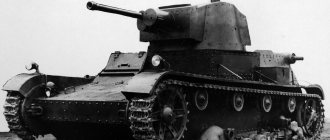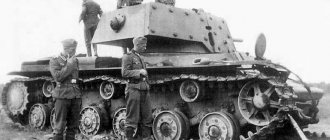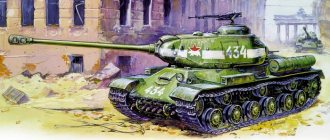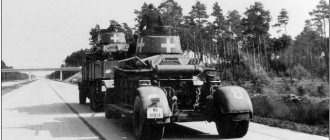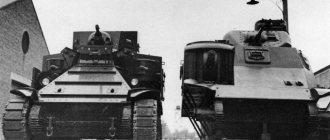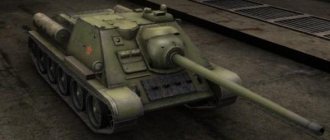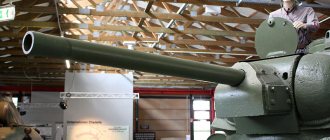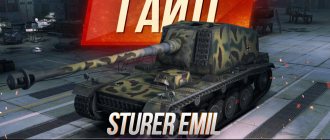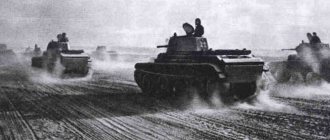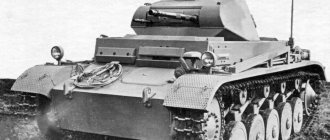Home » Real story » History of Wars » Yuri Pasholok. Tested in the USSR. Cruiser tank Cromwell IV
History of WarBooks on the history of tanks
byakin 05/12/2019 1459
14
in Favoritesin Favoritesfrom Favorites 7
During the Great Patriotic War, more than 5,000 tanks produced in Great Britain and Canada were sent to the Soviet Union under the mutual assistance program. The vast majority of them were tanks of the so-called infantry type, which had powerful armor and low speed. Deliveries of light tanks were limited to 20 Tetrarchs. As for cruising tanks, they never made it into the Red Army. Everything was limited to testing, although initially the mood to receive “Cromwell” from the British was very high. You can learn about the reasons for the abandonment of these combat vehicles from this article, and you can see the English Cromwell IV tank in full detail in a photo review from the exhibition of the museum of military equipment in the Netherlands Overloen.
According to foreign intelligence data
The idea of supplying cruiser tanks to the USSR was first voiced in the spring of 1942. Then the British offered, in addition to the Matildas, Valentines and Churchills, cruising tanks Cruiser Tank Mk.VI, which in the spring of 1941 received the designation Crusader. This vehicle, the successor to the Cruiser Tank Mk.III and Mk.IV, began production at the end of 1940. In fact, it was a completely new tank, much more successful than its predecessors. At the same time, he retained some of their congenital deficiencies. This was especially true for the weak armor and not very reliable Nuffield-Liberty engine.
In response, the Main Armored Directorate of the Red Army (GABTU KA), through the relevant authorities, requested information on the Crusader. In addition to official channels, external intelligence was also involved, thanks to which there was accurate information on the volume of tank production and knowledge of the factories where they were produced. First of all, the English cruiser tank was abandoned due to its gasoline engine. The rest of the British tanks that arrived in the USSR had diesel engines. In addition, information was received and analyzed about the use of Crusaders in Africa: the Germans considered these vehicles to be fast, but poorly armored.
Cromwell IV with registration number T.187888, NIIBT Test Site, September 1944
Meanwhile, the War Ministry started thinking about replacing the Crusader at the end of 1940, that is, at the time it was launched into production. A specification was developed and received by three firms - Vauxhall, Nuffield and the Birmingham Railway Carriage and Wagon Company (BRC&W). The Nuffield A24 project was recognized as the most successful. The Crusader base was used as the basis for the 27-ton vehicle. The tank was adopted as the Cruiser Tank Mk.VII, or Cavalier. However, the car’s career did not work out from the very beginning. The reason for this was the same ill-fated Nuffield-Liberty engine. This opened the way for the Crusader III tank, armed with a 6-pounder (57 mm) gun.
They did not abandon the problematic car; it was decided to modify it. As a result, 2 more tanks appeared. Both cars had the A27 index, differing only in the letters at the end. The A27L index was given to the Leyland Centaur tank, equipped with a Nuffield-Liberty engine. The A27M index was given to the Cromwell tank produced by BRC&W, equipped with Meteor engines, a derated version of the Merlin aircraft engine. The new engine turned out to be not only much more reliable, but also a third more powerful.
Soviet specialists became acquainted with the new tank back in 1942. On November 13, a member of the USSR trade mission in Great Britain, K. Olkhovsky, visited the central tank training ground in Chobham. At the training ground, he and members of the USSR Military Mission were shown two experimental Cromwell Is, which had not yet been armed.
During testing, one of the tanks demonstrated a smooth ride over rough terrain. At the same time, minor malfunctions occurred in the gearbox, and after 5 kilometers of off-road driving, water began to boil in the radiator. The suspension springs broke several times. At Olkhovsky's request, the British presented the characteristics of the tank. The vehicle's combat weight of 27 tons caused him distrust. In addition, Olkhovsky was under the impression that the purpose of the demonstration was to show that the machine was not ready. In his opinion, the British did not want to send the Cromwells instead of the Matildas and Churchills. In reality, the tank was really crude, and it took at least another year to finish it.
The tank is richly decorated with instructions for port workers. For example, across the stern there is a banner “Do not transport on the upper deck!”
In March 1943, GRU agents became aware of the mass production of the Cromwell, Centaur and Cavalier. A report was drawn up, which through the head of the 3rd Directorate of the GRU KA, Major General V. E. Khlopov, was transferred to the Main Armored Directorate (GBTU). According to the report, the number of Cromwells produced reached 8-10 thousand (!) by March 1943, 45 of them were produced every day by 15 enterprises. This information was received from the same Olkhovsky.
Based on the information received, Khlopov proposed no longer purchasing Matildas, but requesting a new type of tank. On April 3, Colonel-General Fedorenko, head of the GBTU of the Spacecraft, approached Molotov with a proposal to purchase Cromwell tanks instead of the Matildas. The USSR Trade Mission in Great Britain, as well as GRU agents, were tasked with obtaining as much information as possible on the new British tanks. It quickly became clear that the Centaur was equipped with a Nuffield-Liberty engine, so interest in it immediately faded. However, the offer to supply Centaur took place, since on May 14, 1943, a response was received from the British Military Mission to the USSR.
The same tank, front view
According to the answer, the British were ready to supply Centaurs (as the Centaur is indicated in the document), but the War Ministry proposed increasing the supply of Sherman tanks instead. We were talking about the M4A2 in the “English” configuration (English radio stations and some changes in equipment), which in the British army had the Sherman III index. That is, the British offered to resell to the Soviet Union tanks supplied, in turn, by the Americans for the British.
Judging by the correspondence, this is what happened in the end. However, the British were ready to demonstrate the Centaur to Soviet representatives in Great Britain. At this point, activity on new tanks died down, since the M4A2, even in the English configuration, GBTU KA seemed more interesting.
Advantages and disadvantages
Once you’ve clearly seen the technical and tactical characteristics of the Cromwell in comparison with the most prominent representatives of Tier 6 medium tanks, we’ll move on to highlighting the strengths and weaknesses of the equipment.
Advantages:
- excellent dynamics;
- high rate of fire;
- a balanced weapon in terms of accuracy, damage and penetration;
- comfortable UVN;
- best DPM among classmates;
- good stealth.
Flaws:
- weak armor;
- frequent damage to the ammunition rack;
- poor gun stabilization;
- small alpha strike;
- high probability of fire;
Better late than never
The next time the Cromwells were remembered was in the spring of 1944. In a letter dated March 17, Deputy People's Commissariat of Foreign Trade I.F. Semichastnov requested Fedorenko's opinion on the feasibility of purchasing these machines. The letter emphasized that, according to Semichastnov, the Cromwells were the best tanks produced in Great Britain. By that time, supplies of British armored vehicles were coming to an end.
This time things went much further than simple correspondence. GBTU KA ordered 6 tanks, some of which were used for testing, including shelling of the hull and turret, and at least a couple of vehicles were sent to specialized institutions for disassembly and study. For various reasons, 6 tanks arrived at the port of Baku only on August 18, 1944. According to the documents, they were supposed to be loaded onto the train on August 24, but in reality there was a delay of 5 days.
Construction of the engine-transmission compartment
It is necessary to dwell separately on what kind of tanks arrived in the Soviet Union. Many copies have been broken about these machines by amateurs of military history who are not very competent in the matter. The information that they belonged to the Cromwell VII modification is not true. In reality, the vehicles sent belonged to the most widespread version, Cromwell IV. The tanks were produced in May 1944, that is, new vehicles arrived in the USSR. The only strange thing is that their body type is indicated in the documents as “E”. If the engine plate meets this hull specification, then the driver's assistant hatch fits the “B” and “C” hulls.
By the time the Cromwells arrived in the Soviet Union, vehicles of this model had already been actively fighting in Normandy for three months. Only the 7th Panzer Division had Cromwells as its main combat vehicles. In the 11th and Guards Tank Divisions, the Cromwells made up about a third of the tank fleet, while the main battlehorse was the Sherman V (M4A4 Medium Tank in English configuration). The Cromwells of the 1st Polish Tank Division were in approximately the same ratio. Another tank formation that Cromwell had was the Czechoslovak Tank Brigade, almost entirely equipped with British vehicles.
In general, English tank crews were skeptical about the Cromwells, considering the Shermans to be more successful. American tanks were more reliable, less voracious and in no way inferior to the British in firepower, while having a more successful hull and turret design.
Testing a tank on a country road
Soviet intelligence did not know about such an attitude towards British tanks among the troops, although some information did reach them. According to the information received, the exhaust system of the English tank turned out to be unsuccessful. The rising exhaust gases unmasked the car, especially in calm, damp weather. To combat this, special screens were quickly made from tin, which, however, reduced the possible declination angles of the gun when firing backwards, and their design turned out to be short-lived.
The design of the mud flaps also turned out to be unsuccessful, as they quickly bent and came off on rough terrain. The shiny metal began to unmask the car. The design of the driver's escape hatch caused criticism. The design of the gun mantlet was considered unsuccessful. A case was recorded of a mask being pierced in the area of the coaxial installation of a BESA machine gun, and the loader was killed.
Equipment
Choosing the right equipment for your Cromwell will help reduce the impact of the disadvantages and increase the effectiveness of the machine's advantages:
- medium caliber gun rammer - the tank's high rate of fire will be even better by reducing the reload time by 10%;
- improved ventilation Class 2 - will give a 5% increase to the crew’s skills, which will slightly increase all the characteristics of the tank;
The choice of the third slot depends on individual preferences and goals in battle:
- coated optics - will add 36 meters to the basic visibility, which will allow you to act more boldly on the front line in the role of a scout;
- reinforced aiming drives - initially long aiming interferes with effective play, negating fast reloading, so by reducing aiming time you can significantly increase shooting comfort.
Map
Where to go on Cromwell? You can play two hundred or three hundred battles, simultaneously studying the map up and down, but the risk of spoiling the rating with such research is very high, so it is better to first obtain the necessary information for a certain type of combat vehicle.
Local knowledge is a huge advantage for any gamer. On a global scale, this makes it possible to find out where the maximum area covered by fire is covered, where it is better to stand so as not to be exposed, and where the main fight takes place. From a local point of view, there are also many advantages: where you can quickly hide from fire, where it is convenient to play from the body or from the tower, how best to bypass your opponent.
For Cromwell, a place with good visibility, an escape route, and the ability to rush into the thick of things if necessary would be a good choice.
Armament
The main armament of the cruising tank is a 57 mm cannon, the barrel length is 50 calibers. Various modifications of the Cromwell were equipped with a 95 mm howitzer.
The gun was mounted on the front of the turret in a square mantlet with an additional armor plate. The tank was also equipped with auxiliary weapons: 27.7 mm machine guns - British modifications of Czechoslovak guns. One machine gun was attached as a coaxial one to the main gun, the second - to the left side of the hull in front. The set of charges included 3000 rounds.
Role on the team
In addition to good individual playing skills, it is important to understand your place in the team, because collective success is higher than individual success. It is very rare that one gamer can fight back against a team, especially if it is well coordinated. Playing together is what makes World of Tank interesting. How to play Cromwell in a team in this case?
Here you need to remember that the “British” is a medium tank, whose trump card lies in the balance between speed and weapons. So, you can play the role of a firefly and give away the location of enemy units to your allies, or you can be support. Cromwell is a tank with little damage, and, most likely, will only harm the enemy, and someone else, a more powerful vehicle, will take the frag. It's a shame, of course, but such is the fate of the middle peasants. Although the FBR is omnipotent and unpredictable, so it may turn out that it is Cromwell who will score the largest number of frags.
Equipment selection
At level 6, you can get by with regular equipment. The set has a standard form:
- repair kit;
- first aid kit;
- fire extinguisher.
It is better to take an automatic fire extinguisher because it will reduce the chance of a fire by 10% and save more hit points when set on fire.
An alternative option for the third slot is the national dish in the form of Pudding with tea. Considering the fire hazard level of the tank, the effectiveness of a 10% increase in crew skills is questionable, but it also has the right to life if there is a sufficient amount of credits and courage.
Perks
What else does Cromwell desperately need? World of Tank took care not only of the intricacies of development and improvement of equipment - the crew also did not stand aside. Perks, that's something to think about.
The first thing you should upgrade for the crew of any vehicle is the light bulb. It’s much easier to play knowing whether the car is illuminated or not. A heavy tank, a tank destroyer, a firefly, and even artillery need this modification.
Further more. As already mentioned, in addition to strengthening strengths, it is necessary to gradually get rid of weaknesses. Therefore, after the light bulb, it is advisable to pump in the stabilizer for mixing.
Then you can download perks at your own discretion. The foundation has been laid.
Observation
This is a very important indicator for all types of equipment. Seeing the enemy in time, highlighting the enemy to your allies and gaining an advantage in battle is an excellent trump card and a guarantee of victory. "British" shows the following characteristics for this item:
- overview - 360 m;
- communication range - 570 m.
The indicators are very average, but not bad for this technology.
Tactics for playing Cromwell
The tank is fully equipped, the main characteristics have been reviewed, and now you should understand that you need to play this Briton, trying to maximize its advantages and avoid its disadvantages.
The first thing to always remember is the Cromwell tactics
combat involves maximum caution combined with a creative approach. We cannot rely on armor in any situation, so we will have to use ingenuity and cunning.
Use your mobility advantage with the Cromwell tank
so mobile that in a very short period of time it can change the direction of attack, change the flank, return to base to protect against capture, or vice versa, attack the enemy from the rear.
We feel good playing from distance and camouflage, because Cromwell World of Tanks
It has an accurate and fast-firing weapon, capable of shooting at targets at long distances. By the way, a good DPM gives an excellent advantage in close combat, and by combining this quality with excellent mobility, you can spin less agile opponents, defeating even tanks of a higher level.
Finally remember, medium tank Cromwell WoT
He is very afraid of land mines and artillery shots, and also does not easily resist superior numbers of enemy forces. To avoid getting into a difficult situation, keep an eye on the mini-map and constantly assess the battle situation.
Tactical and technical characteristics of the Cromwell tank
Crew, persons: 5 Layout scheme: classic Developer: Leyland Motors Manufacturer: Nuffield Mechanization and Aero Years of production: 1943—1945 Years of operation: 1943—1980 Number of production, pcs.: 1070
Cromwell tank weight
– 27.97 tons
Dimensions of the Cromwell tank
– Body length, mm: 6350 – Body width, mm: 3050 – Height, mm: 2500 – Ground clearance, mm: 406
Cromwell tank armor
– Hull forehead (top), mm/deg.: 64/ 0° – Hull forehead (middle), mm/deg.: 25/ 68° – Hull forehead (bottom), mm/deg.: 57/ 27° – Side hull, mm/deg.: 32/ 0° – Hull stern (top), mm/deg.: 25/ 0° – Hull stern (bottom), mm/deg.: 32/-10° – Bottom, mm: 6 .5—8 – Hull roof, mm: 14 – Turret front, mm/deg.: 76/ 0° – Tower side, mm/deg.: 51 + 12.7 – Turret rear, mm/deg.: 51 + 12 .7 – Tower roof, mm: 20
Armament of the Cromwell tank
– Caliber and brand of gun: 57 mm QF 6 pounder – Gun type: rifled – Barrel length, calibers: 50 – Gun ammunition: 75 – Sights: No. 33 or No. 39 MkII – Machine guns: 2 × 7.92 mm BESA, 1 × 7.7 mm Bren
Cromwell tank engine
– Engine type: Rolls-Royce Meteor V-shaped 12-cylinder carburetor liquid cooling – Engine power, l. pp.: 600
Speed of the Cromwell tank
– Highway speed, km/h: 64 – Cross-country speed, km/h: 28
– Cruising range on the highway, km: 278 – Specific power, l. s./t: 21.5 – Suspension type: individual spring, Christie suspension – Specific ground pressure, kg/cm²: 0.97 with a track width of 394 mm – Climbability, degrees: 24 – Climbable wall, m: 0 .9 – Overcoming ditch, m: 2.3 – Overcoming ford, m: 0.9—1.2
Crew training
The Cromwell crew consists of 5 tankers, without combined specialties, so everyone plays their role. Perks are no less important than equipment, so a competent approach to leveling them up will help significantly improve the tank’s gameplay.
Let's take a closer look at the impact and order of learning skills.
Cromwell is a dynamic tank that spends most of the battle on the move. This is why it is so important to master repairs from the beginning. The tank has no armor, and the reserve of hit points is not enough to survive longer than 10 seconds under enemy fire.
Poor stabilization of the gun can be corrected by smooth movement and smooth rotation of the turret. By reducing the circle of dispersion, they will contribute to more targeted fire while on the move.
Radio interception will increase visibility by another 11.1 meters.
Considering the location of the ammunition rack along the sides, non-contact ammunition racks will help reduce the likelihood of damage. At the same time, the sniper will allow you to deal increased damage to enemy modules due to the high rate of fire.
It was precisely because of the good combination of the “Sniper” perk and the fast reloading of the weapon that many players chose Cromwell to perform the “Arsonist” LBZ.
Combat Brotherhood together with the “Improved Ventilation” equipment will give a more noticeable increase to all the characteristics of the tank. It is best to select it through resetting skills, because the skill only works if all crew members are 100% proficient.
The best option would be to replace the perks displayed at level 2, because almost all of them work from the moment you learn them.
For the loader, after the reset, put the BoBr first, and then the non-contact ammo rack, in order to learn repairs again at level 3.
At level 4, three crew members can learn camouflage, improving one of the vehicle's strengths. This skill will allow you to remain unnoticed longer and will help you move along the flank to the rear, where your appearance may be a surprise to your opponents.
Brief summary
The Cromwell turns out to be a sought-after vehicle in many situations, and a platoon of such tanks can decide the outcome of a battle. This tank has pronounced advantages and disadvantages, and therefore is demanding of the player’s skills. Due to its high combat effectiveness, it was included in our rating of the best tier 6 tanks.
Find out a full review of the British medium tanks branch and whether it’s worth downloading here

